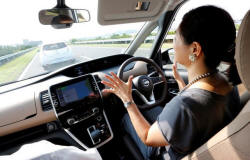|
Nissan launches auto
drive features, stresses difference from hands-free
driving
 Send a link to a friend
Send a link to a friend
 [July 13, 2016]
YOKOHAMA (Reuters) - Nissan Motor Co
Ltd launched a suite of semi-autonomous driving functions on Wednesday
stressing they were intended to assist and not replace drivers, just two
weeks after similar technology in another maker's car was involved in a
fatal crash. [July 13, 2016]
YOKOHAMA (Reuters) - Nissan Motor Co
Ltd launched a suite of semi-autonomous driving functions on Wednesday
stressing they were intended to assist and not replace drivers, just two
weeks after similar technology in another maker's car was involved in a
fatal crash.
Japan's second-ranked carmaker by vehicle sales said its ProPilot can
drive a vehicle on single-lane motorways and navigate congestion. It
said the feature will first appear on a Serena minivan model on sale in
Japan from next month.
As global automakers race to develop self-driving cars, the safety of
current automated systems was called into question by U.S. investigators
saying a driver died in a crash while the autopilot of his Tesla Motors
Inc Model S was engaged.
While Nissan declined to comment directly on that incident, Executive
Vice President Hideyuki Sakamoto said it was important drivers did not
overestimate the purpose and capabilities of automated driving
functions.
"These functions are meant to support drivers, and are not meant as
self-driving capabilities" which let drivers take their eyes off the
road, he said. "These are two very different things."

Pushing a button on the steering wheel activates ProPilot, which keeps
the vehicle a fixed distance from the car in front without requiring the
driver to control the steering, accelerator or brake.
Like Tesla's similar technology, ProPilot requires drivers to keep their
hands on the wheel. A warning sign flashes if the wheel is released for
more than around four seconds, and an alarm sounds after 10 seconds.
General Manager Tetsuya Iijima at Nissan's Advanced Technology
Development department said it was up to automakers to educate drivers
about the capability of automated driving functions to prevent misuse
that could lead to accidents.
"Naturally, there are limitations to the system, and our job is to
communicate what those limitations are," he told reporters.
[to top of second column] |

Reuters auto correspondent Maki Shiraki removes her hands from the
steering wheel as she test drives Nissan's new Serena minivan, which
is equipped with Propilot semi-automated driving functions, at the
company's test drive facility in Yokosuka, Japan July 12, 2016.
REUTERS/Toru Hanai

With ProPilot, Nissan joins many automakers including Tesla, BMW and Daimler
AG's Mercedes-Benz in marketing adaptive cruise control and traffic jam
assistance.
Nissan will sell its ProPilot-equipped Serena for under 3 million yen ($28,758),
making it one of few mid-priced vehicles with autopilot features more common
among luxury cars.
The automaker also plans to add ProPilot to Qashqai sport utility vehicle
crossover models in coming months, and introduce the feature in the United
States and China.
Nissan continues to aim for autonomous multiple-lane driving, including lane
changes, by 2018, and functions for full urban driving, including intersection
turns, by 2020.
(Reporting by Naomi Tajitsu; Editing by Christopher Cushing)
[© 2016 Thomson Reuters. All rights
reserved.] Copyright 2016 Reuters. All rights reserved. This material may not be published,
broadcast, rewritten or redistributed.

 |